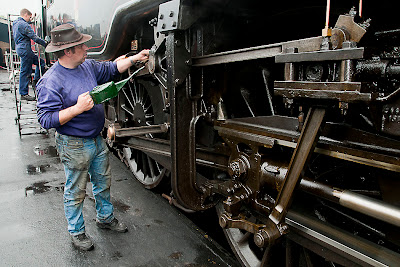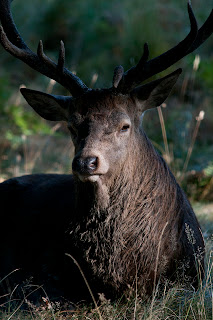I made a few visits to The Bluebell Railway in Sussex for the purpose of this exercise. It is a heritage railway run entirely by volunteers offering trips along a short section of closed line to members of the paying public. An incredible amount of work goes in to keeping this railway running, much of it behind the scenes before the stations are even open for business.
 |
| Cover Shot Southern 1638 emerges from Sharpthorne Tunnel in Sussex |
I selected this image as my cover shot. It shows the train emerging from the darkness of a tunnel into the morning sunlight. The age of steam is not dead. There is plenty of room within the image to add the cover text as may be required.
 |
| Image 1 Early morning autumn sunlight bathes the yard as the railway springs into life |
Work starts early getting the trains prepared and ready for service. Image 1 shows the yard at this time of day with many people keeping themselves busy.
 | |
| Image 2 Filling the tender with coal. Train cleaners look on from another locomotive |
Image 2 shows plenty of activity in getting the trains ready for service. The green train is having the tender loaded up with coal. Meanwhile two men are busy giving the blue train a clean and polish.
 |
| Image 3 Hot, thirsty work. The unenviable lot of the fireman |
Image 3 shows the unenviable lot of the fireman. Of course no self respecting railway could run without the prerequisite brew cans!
 |
| Image 4 The authenticity of the railway even stretches to the oil cans |
Image 4 and Image 5 would appear on the same page or pair of pages. Without the first image there could not be a second. Preparation and painstaking attention to detail are essential to keep these old machines running smoothly. The olde worlde oil can being used just looks so right in this image. After much preparation the train is ready to run and offers a sight that many people never tire of seeing.
 |
| Image 5 The glory of steam! Southern 1638 at speed |
Of course all this hard work is aimed at one thing. To give a pleasurable experience to people, especially the many children who come to visit with their parents (Image 6). These paying passengers provide the much needed funds to keep the railway running of course and it is clear to see they seem to be getting value for money!
 |
| Image 6 A prospective future driver enjoying the day! |
ASSIGNMENT FEEDBACK
Overall Comments
Thanks for sending me what I believe to
be your best assignment so far. I see you have now posted the images
and text on your blog; as usual the layout and captioning is
excellent. The standard of the photography is consistent across the
whole set, in fact each image makes a statement in its own right.
Together they convey a comprehensive impression of the railway, its
volunteers and visitors, in only six images.
For assignment four’s feedback I gave
you tips on how to tackle this assignment, as well as the usual, more
general feedback. You have responded by combining all of my advice
with the knowledge and techniques that you have learnt during the
module: concepts, composition, colour, lighting and finally
narrative.
Feedback on assignment
This was a technically demanding
assignment. Strong, low autumn light looks great when handled
correctly, but it can be difficult to balance high contrast,
especially when black locos and white steam are added to the
equation. The first two images use backlighting well to show the
steam and reflections on tracks. The only overcast shot was used to
render the reflective, oily metalwork of the engine with subtlety.
The harsh sunlight on a light shirt and black engine in image 3 have
both retained detail, as well as the flames in the firebox.
Your exposures are well controlled
throughout; even image 5, which was a difficult balancing act. The
shutter speed chosen in that shot has rendered details sharp on the
loco, yet also shows motion blur on the wheels, giving a sense of
speed.The composition and framing of this assignment are a real
improvement on the first four. Most images employ a clear focal
point, or a clear arrangement of several (e.g. implied triangles in 2
and 6). Most images also use diagonal lines to draw the eye into the
frame (e.g. 1, 3, 4 and 5).
Your editing and sequencing also
impress me. The opening shot is simple, striking and (as you point
out) ideally suited to overlay with text. Image two is the story
telling image to start with, showing the wider view, two locos,
tracks, volunteers and scenery; it illustrates the context of the
location. The next three show the teamwork of the volunteers, all
nicely composed and without any distractions. Finally, taking a step
back from the action, photographing the photographer, highlights the
visitor experience. This gives an idea of the railway’s engagement
with the public, generating funding for the railway’s continuation,
as well as inspiring future generations to get involved.
In total, the set gives a well-rounded
impression of the railway including context, action, portraits,
close-ups and the visitors. I’d suggest editing the captions with
the images for assessment, with the sort of narrative style captions
you might expect to see in a magazine or an exhibition for the
railway; just a sentence or two is enough.
At the moment the captions are good for
the assignment as it is sent to me, but this assignment needs an
overall look and feel as if it’s ready for the outside world. For
example, image one starts and ends with messages for me (perhaps),
but not messages that you’d put in a magazine.
Learning Logs or Blogs
As
per my comments last time, I can see in your blogadequate reflections
on your own work.For assessment, you will need to show more evidence
of viewing other photographers’ work, in books, online or at
exhibitions. The learning log accounts for 20% of the marks at
assessment, so it’s worth adding all the reflection that you can on
what you have experienced throughout the module, as this is an
important part of the log.
Suggested reading/viewing
I recommend reading100 Ideas that
Changed Photography by Mary Warner. Also, look on the webthe
photography of William Klein; a great photographer of people. You may
notice one of his most famous images has a similar look to your
self-portrait with pistol. For rail shots, particularly those in the
greater context, take a look at the images of O. Winston Link if you
don’t know his work already. He often used great banks of flash
heads that must surely have been a hazard to the train drivers, but
allowed spectacular night photography.
Pointers for the next
assignment
Module completed.
|
Tutor name:
|
Derek Trillo |
|
Date
|
18January 2013 |
|
Next assignment due |
Module completed |
































































